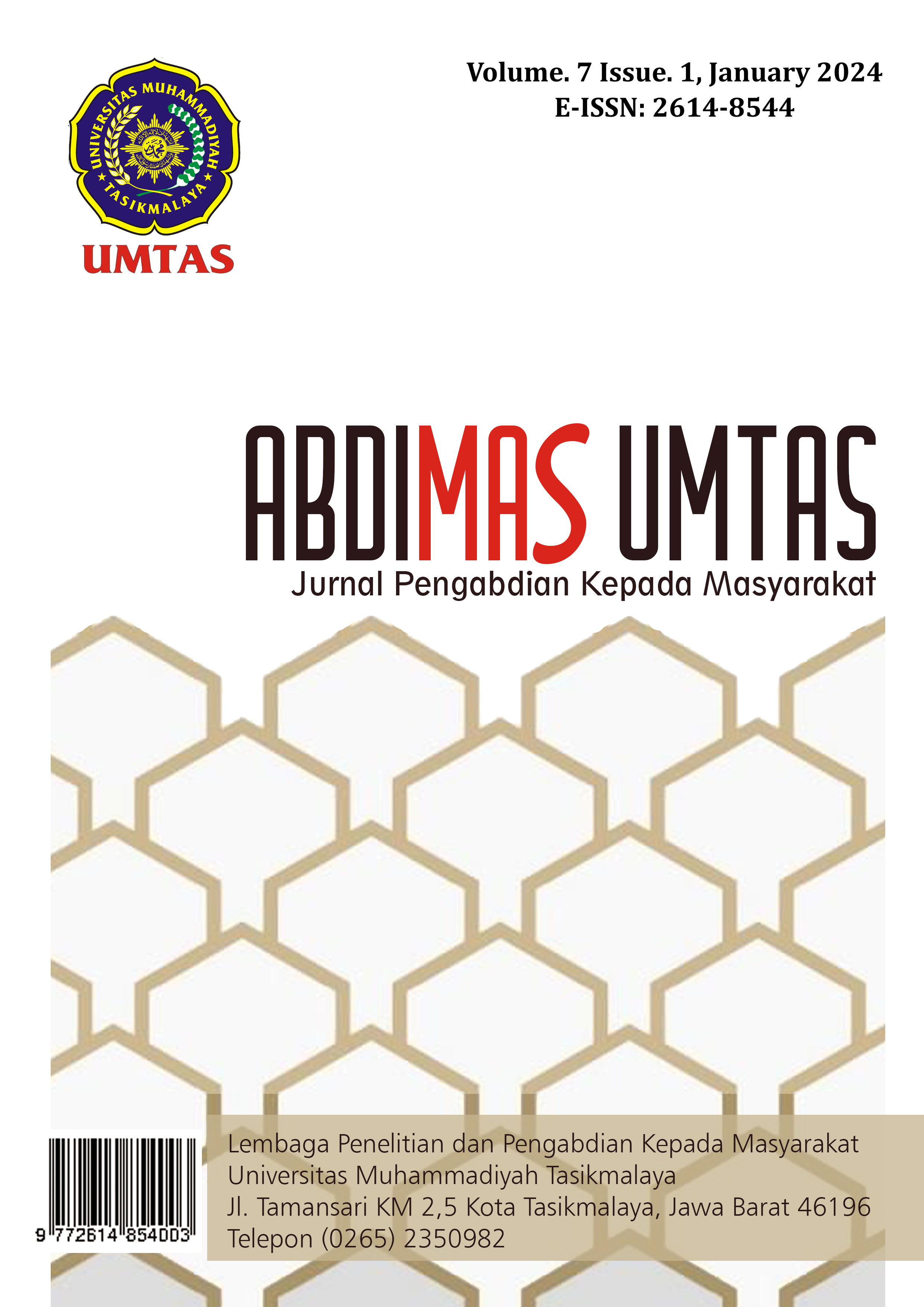Behavioral Change Interventions in Dental Hygiene for Prevention of Dental Caries in Children at SDN 09 North Pontianak
DOI:
https://doi.org/10.35568/abdimas.v7i1.4151Keywords:
drinking water, dental hygiene, fluoride, dental caries, behaviorAbstract
West Kalimantan has extensive peatlands, so its groundwater has a low calcium and fluorine content. The low content of these two minerals can make teeth susceptible to damage and affect the development of children's teeth. The high rate of dental caries in children requires intervention in order to change dental hygiene behavior and prevent further development of dental caries. Method: The intervention was carried out by training dental hygiene to first grade students of SDN 09 North Pontianak and their parents. This study used promotive and preventive approaches by training both parents and children on the proper way to do dental and oral cleaning. Routine training after school in small groups with the assistance of an instructor was held for the students. Parents then help and supervise the child when brushing their teeth at home twice a day and report it in the diary that has been prepared. Result: Behavioral changes including frequency, duration, tooth brushing technique, tongue cleaning, and oral cleaning after eating, were obtained after the intervention. An increase in teeth and mouth cleaning skills was found to be in line with a decrease in plaque value (PHP-M Index) from 29.66 to 16.39. Conclusion: Tooth-brushing training activities can improve children's ability to clean their teeth and mouth. A tooth-brushing diary can be a medium to remind children about when to brush their teeth. The role of parents is to increase children's motivation to develop dental and oral cleaning behavior.
Downloads
References
A’idah, E., Destiarti, L., & Idiawati, N. (2018). Penentuan Karakteristik Air Gambut Di Kota Pontianak Dan Kabupaten Kuburaya. Jurnal Kimia Khatulistiwa, 7(3), 91–96.
Astiani, D., Burhanuddin, B., Gusmayanti, E., Widiastuti, T., & Taherzadeh, M. J. (2018). Enhancing water levels of degraded, bare, tropical peatland in West Kalimantan, Indonesia: Impacts on CO2 emission from soil respiration. Biodiversitas Journal of Biological Diversity, 19(2), 472–477. https://doi.org/10.13057/biodiv/d190221
Ástvaldsdóttir, Á. et al. (2016). Arginine and Caries Prevention: A Systematic Review. Caries Research, 50(4), 383–393. https://doi.org/10.1159/000446249
Azodo, C. C., Ehizele, A. O., Umoh, A., Ojehanon, P. I., Akhionbare, O., Okechukwu, R., & Igbinosa, L. (2010). Tooth brushing, tongue cleaning and snacking behaviour of dental technology and therapist students. Libyan Journal of Medicine, 5(1), 1–5. https://doi.org/10.3402/ljm.v5i0.5208
Hobdell, M., Petersen, P. E., Clarkson, J., & Johnson, N. (2003). Global goals for oral health 2020. International Dental Journal, 53(5), 285–288. https://doi.org/10.1111/j.1875-595X.2003.tb00761.x
Kementrian Kesehatan Republik Indonesia. (2018). Laporan Nasional Riset Kesehatan Dasar 2018. 1–582.
Kyaw Myint, Z. C., Zaitsu, T., Oshiro, A., Ueno, M., Soe, K. K., & Kawaguchi, Y. (2020). Risk indicators of dental caries and gingivitis among 10−11-year-old students in Yangon, Myanmar. International Dental Journal, 70(3), 167–175. https://doi.org/10.1111/idj.12537
Pierce, A., Singh, S., Lee, J., Grant, C. G., De Jesus, V. C., & Schroth, R. J. (2019). The Burden of Early Childhood Caries in Canadian Children and Associated Risk Factors. Frontiers in Public Health, 7, 328.https://doi.org/10.3389/fpubh.2019.00328
Pramudho, P. K., & Hermawan, N. S. A. (2019). Hubungan Perilaku Ibu dengan Timbulnya karies gigi pada Siswa. Jurnal Dunia Kesmas, 8(1), 33–36. https://core.ac.uk/download/pdf/328113595.pdf
Purwaningsih, E., Aini, A. S., Ulfah, S. F., & Hidayati, S. (2022). Literature Review: Perilaku Menyikat Gigi Pada Remaja Sebagai Upaya Pemeliharaan Kesehatan Gigi Dan Mulut. Jurnal Kesehatan Gigi Dan Mulut (JKGM), 4(1), 15–23. https://doi.org/10.36086/jkgm.v4i1.819
Purwasih, Sapriani, I., & Slamet. (2018). Jurnal Laboratorium Khatulistiwa. Jurnal Laboratorium Khatulistiwa, 2(2), 145–151.
Puspa Dewi, S. R., Safitri, Y., Lany, L. E., & Dwi, R. S. (2019). Gambaran Kadar Fluorida dalam Air Minum dan Skor Dmf-T Anak 12 Tahun di Sungai Pedado Palembang. Jurnal Riset Kesehatan, 8(1), 68. https://doi.org/10.31983/jrk.v8i1.4089
Qin, M., Li, J., Zhang, S., & Ma, W. (2008). Risk Factors for Severe Early Childhood Caries in Children Younger Than 4 Years Old in Beijing, China. Pediatric Dentistry, 30(6), 507–5132008.
Rathee, M., & Sapra, A. (2020). Dental Caries - StatPearls - NCBI Bookshelf (pp. 1–7). https://www.ncbi.nlm.nih.gov/books/NBK551699/
Selwitz, R. H., Ismail, A. I., & Pitts, N. B. (2007). Dental caries. The Lancet, 369(9555), 51–59. https://doi.org/10.1016/S0140-6736(07)60031-2
Wulaerhan, J., Abudureyimu, A., Bao, X.-L., & Zhao, J. (2014). Risk determinants associated with early childhood caries in Uygur children: a preschool-based cross-sectional study. BMC Oral Health, 14(1), 136. https://doi.org/10.1186/1472-6831-14-136












